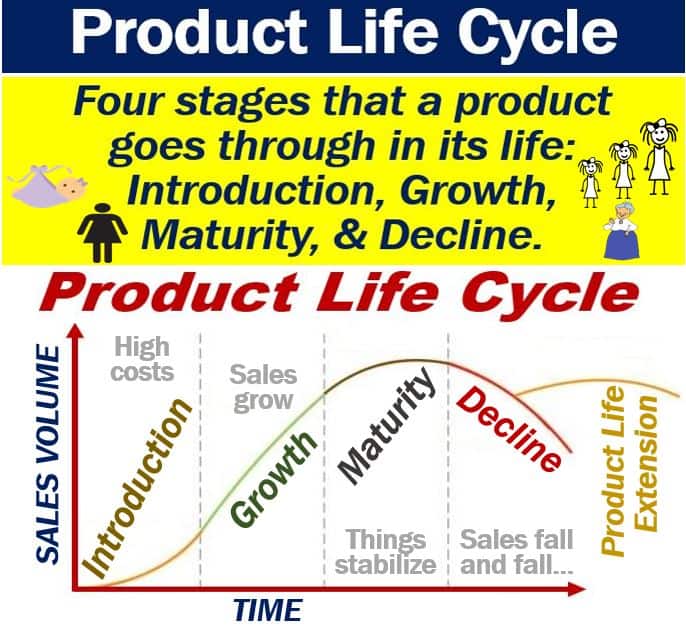A Product Life Cycle is the time a product is in the market throughout its different stages. The stages are introduction, growth, maturity, and decline.
Companies determine how each stage affects the product’s profit. Business executives try to maximize the product’s value through each stage.
Every company wants each product to have a long commercial life. In other words, they want the product life cycle to be as long as possible.
Determining or predicting a product life cycle is extremely difficult. Nobody can accurately foretell how consumer tastes and preferences might change in five or ten years’ time.
Additionally, businesses can only focus on each product individually.

Product life extension is all about lengthening a product’s commercial life, i.e., the product life cycle. According to TechTarget: “Extension strategies include rebranding, price discounting, and seeking new markets.”
Product life cycle – Introduction
The first stage, introduction, is when the seller first introduces the product into the market. It’s important to focus on raising product awareness and increase its market share.
This stage is usually the most expensive one for the seller. It is when it spends the most on advertising and promotion. Sales, however, are still low. Therefore, profit is low.
During this stage, the seller generates a relatively high production cost due to the low sales.
Whenever you plan to launch a new product, make sure you have budgeted for the high costs.
To attract customers, you will need to implement a heavy marketing and promotion strategy.
Product life cycle – Growth
When the product has reached the growth stage, it means it survived the first stage. This is when customers and competitors start becoming aware of it.
This is also the period during which the product is booming. Sales increase rapidly as marketing campaigns now focus on mass rather than a specific target.
Companies want their product to remain in this phase as long as possible. It’s important to focus on building a brand preference to increase market share.
-
Market share
Market share refers to how big your slice is of the market pie. We usually express it as a percentage.
An increase in market share during the growth stage can lead to economies of scale, reducing the cost per unit and boosting profitability.
Let’s imagine your product is a motorbike. You sold 10,000 units last month out of a total of 200,000 units. Your market share was 5%. Ten thousand is five percent of two-hundred thousand.
Product life cycle – Maturity
At the maturity stage, the product has finally reached a stable position. Sales will slow down, and competitors will emerge will similar products.
During this stage, companies have to focus on maintaining their market share through promotions. Prices may also have to come down.
-
Product differentiation and prices
During the maturity stage, companies focus on product differentiation and price reductions. These two strategies help them maximize profits.
Product differentiation is the process of distinguishing a product or service from others. The seller aims to make the product more appealing to a specific target market. In other words, the seller tries to make the product stand out.
Maturity is usually the longest of the three stages. It is not uncommon to have a product at maturity for decades.
Product life cycle – decline
Unfortunately, all good things come to an end. After enjoying a long period of maturity, most products then start declining. In this context, decline refers to sales, and sometimes market share too.
Profits also begin to decline during this phase. Manufacturing the product becomes less and less economically viable over time.
In other words, it eventually becomes impossible to manufacture it and still make a profit.
Strategic partnerships or technological advancements can sometimes revitalize a declining product, offering new avenues for growth and profit.
It is also during the maturity stage that the market becomes saturated, i.e., everybody has it.
Sometimes, a new product comes onto the market that pushes yours into the decline stage. In fact, new products often kill off existing ones.
For example, compact discs or CDs killed off audio and video cassettes. A couple of decades later, online streaming started killing off CDs.
One way to prolong this stage is to find cheaper production methods. It might also be possible to find cheaper markets.
However, eventually the maturity stage ends, and the product dies.
Adding new features may extend a product life cycle. Adopting a different market strategy sometimes works too.
The iPhone, for example, has been extending its product life cycle with regular updates.
